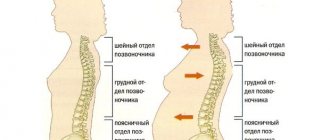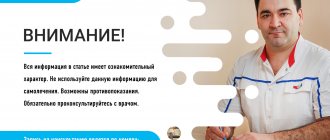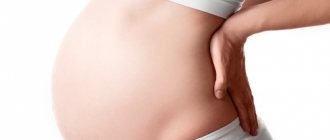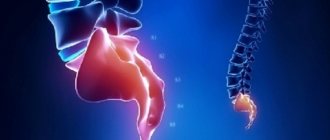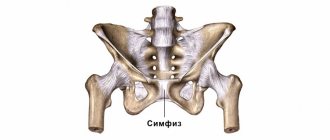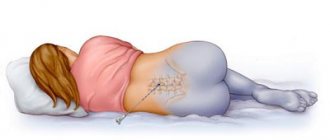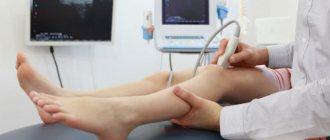In the life of every woman, the time of waiting for the birth of a child is one of the most beautiful and exciting. However, it can be overshadowed by the onset of various unpleasant phenomena and symptoms of diseases. Thus, expectant mothers often complain that their tailbone hurts during pregnancy. In some cases this phenomenon is completely normal, in others it is a sign of pathology. Therefore, you should not hesitate to visit a neurologist
, because the health of the woman and baby depends on the timely identification of the causes of pain.
Why does the tailbone hurt during pregnancy?
There can be many manifestations of pain, varying in duration, intensity and other characteristics. It is worth considering the main reasons why pain in the lower back occurs during pregnancy.
Pregnancy related
If your tailbone hurts during pregnancy, this may be completely normal. The fact is that already in the first stages, the body of the expectant mother produces a hormone called relaxin, the main task of which is to soften the connective tissue in the joints and ligaments. The more this hormone is in the blood, the more the coccygeal bone will deviate back, which causes pain. In the second trimester, due to the increase in the size of the uterus, the uterosacral ligaments also increase, the pelvic bones tighten, as does the tailbone. This process is a kind of protective mechanism for successful gestation, but at the same time it can cause very unpleasant sensations. If there is a threat of miscarriage, the tailbone begins to pierce and hurt; the pain also spreads to the lower abdomen. In later stages of pregnancy, the tailbone often also hurts. This may be due to the fact that the child’s head presses on the tailbone, which leads to discomfort. The woman often notes that the pain increases sharply when laughing, sneezing and any muscle tension.
Trauma-related
Any injury to the coccygeal bone that a woman received at one time or another in her life may be the reason why the tailbone hurts during pregnancy. Even if in her youth she hit her tailbone on the seat of a swing, an old injury can cause pain. If there is a history of untreated fractures, dislocations, cracks, the pain will be especially intense. It may also happen that the tailbone hurts during pregnancy in the second trimester due to pathological processes in the intestines, gynecological parts, etc. For example, if there is intestinal cancer, the coccyx bone will begin to ache at the very beginning of pregnancy. Another problem may be a pinched nerve or problems with the nervous or muscular system. Later stages of pregnancy are often more difficult due to inflammation of the sciatic nerve. In this case, the intensity of the pain syndrome increases sharply at night and when one or another organ gets cold.
Diagnostic methods
If you experience even minor pain in the tailbone area, you should consult a doctor. To accurately diagnose the condition, an examination of the pregnant woman is necessary. In addition, the doctor may prescribe additional examinations that will allow you to fully assess the condition of the pregnant woman:
- ultrasound examination - allows you to determine the size of the pelvis and the location of internal organs;
- radiography – is carried out to identify the curvature of the coccyx and determine its shape (devices with low radiation are used);
- rectal examination;
- blood test - to determine the level of the hormone relaxin and progesterone (prescribed in the first months of pregnancy).
During the examination, it is necessary to inform the specialist about early pelvic injuries. Diagnostics allows you to determine the nature of the pain and the cause of the discomfort. Based on the data obtained, the gynecologist makes a conclusion about the further management of childbirth (natural birth process or cesarean section).
Nature of pain
The causes of coccygeal pain have a great influence on the nature of the discomfort. Each woman whose tailbone hurts during pregnancy in the first, second or third trimester describes the situation in her own way and says that the pain:
- pulling;
- spicy;
- sharp;
- piercing;
- appear in fits and starts;
- permanent
Often in the second trimester of pregnancy, the tailbone hurts more noticeably when a woman tries to bend over, stands on her feet for a long time, sits in an uncomfortable position, etc. For some, pregnancy proceeds easily and without complications, while for others, pain in the tailbone appears constantly, causing very severe discomfort and chaining to the bed. Sometimes such pain radiates to the intestines, lower abdomen, pelvic organs, perineum, and even legs. Often, expectant mothers complain to the doctor that they cannot move normally due to acute pain and are forced to ask loved ones for help.
How to get rid of pain?
While expecting a child, a woman should listen carefully to changes in her well-being. Continuous pain can spoil the joyful mood, so if discomfort occurs, you should consult a doctor. You should not try to get rid of pain on your own, as many activities are prohibited during pregnancy. You should visit a doctor as soon as discomfort appears. Timely diagnosis helps prevent the development of complications.
Medication approach
It is permissible to use medications during pregnancy only as prescribed by a gynecologist. Many medications are prohibited as they can cause adverse reactions and harm the child.
The remedies are selected individually, taking into account the duration of pregnancy and the reasons that caused the pain. The most effective and safe:
- Traumeel S ointment – rub the tailbone area (used in the first trimester);
- Ibuprofen – take 3 times a day, no longer than a week;
- Diclofenac - apply ointment to the lower back 4 times a day for no more than 10 days, apply suppositories 2 times a day, duration of treatment - up to 1 week;
- Paracetamol - prescribed for the development of inflammation, allowed to be taken 3 times a day.
All medications are allowed only in the second trimester of pregnancy. The use of medications at other times may cause complications and negatively affect the development of the fetus.
Traditional medicine
Effective traditional medicine:
- Honey with radish. You need to mix 30 ml of heated honey with radish juice and apply to the area that aches. Apply a bandage or gauze on top for 20 minutes, then rinse with warm water. Use within a week.
- Lavender oil. You can buy a ready-made product at a pharmacy or prepare it at home. To do this, you need to put lavender flowers in warm sunflower oil and leave the mixture for 2 weeks in a dark place. Apply to the tailbone area for 10 days.
- Geranium decoction. To prepare the decoction, boil the crushed geranium leaves in a liter of water for 5 minutes and cool. Soak gauze in the broth and apply to the sore spot.
- Iodine. Apply to the tailbone area every other day.
- Valerian. Drop a little onto a bandage and apply to the area that hurts. Cover the bandage with a diaper and leave overnight.
- Fir oil. Use several times a day.
- Clay. To prepare, you need to mix the clay with a small amount of vinegar. Apply the resulting mixture to your back in a thick layer. Apply compresses at night.
Special gymnastics for pregnant women
Exercises can be performed only after permission from a doctor. You can’t do gymnastics if you have toxicosis. The complex is aimed at strengthening muscles and reducing pain. If the gynecologist recommends doing gymnastics, it is better to do it using a fitball. Basic exercises:
- Sit on the fitball, rest your hands on a hard surface. Slightly sway on the ball and roll back and forth.
- Lie on your back, place the ball between your knees, alternately squeeze and unclench the fitball with your feet. This exercise helps strengthen your thigh muscles.
- If the pain is severe, you need to move in a circle on the ball.
- Sitting on a fitball, alternate bending to your feet.
- Lie on your back (on the ball), bend your knees and lift your pelvis.
Massage and water treatments
To relieve pain in the tailbone, a therapeutic back massage is prescribed. If it is impossible to take a horizontal position, massage the shoulders. The procedure must be performed by a specialist, since inexperienced movements can aggravate the condition. Most often, massage is carried out in conjunction with water procedures.
Pregnant women are allowed to take warm baths and exercise in the pool. Swimming helps relax muscles and reduce pain.
Pain relief
Often, the doctor does not find pathologies that cause coccyx pain during pregnancy, which means that there are no deviations from the norm. In general, we can say that coccygeal pain during pregnancy is, to a certain extent, considered normal, so it is best to listen to the doctor’s recommendations and follow all the instructions given by him to alleviate your condition. These recommendations have been tested by time and by more than one woman.
Gymnastics
Therapeutic physical education, the use of a fitball during exercise, special gymnastic exercises and yoga for expectant mothers are a great way to alleviate the condition without harm to the health of both your own and your baby. If you experience pain in your tailbone during pregnancy, and the doctor has not found any pathologies, you should ask him what exercises will help you relieve the pain and start exercising regularly. Such exercises, among other things, will strengthen the muscles and also help the woman feel at ease even in later stages. As a result, you will get rid of pain in the coccygeal area and will be completely ready for the upcoming birth.
Acupuncture
If your tailbone hurts during pregnancy, it would be a good idea to visit a physiotherapist or chiropractor. These specialists know how to influence certain points on a pregnant woman’s body to relieve pain and alleviate the condition. Acupuncture is one of the most effective ways to relieve pain, the only thing is that to attend such procedures you must obtain permission from your attending physician. Otherwise, an attempt to improve your well-being can lead to a significant deterioration.
Eliminate pain in the back, lower back, coccyx, sacrum in pregnant women without drugs
The goal of treatment is to create a more optimal distribution of the load from the uterus to the ligaments, bones and muscles. What can be safely used during pregnancy:
- Gentle correction of the spine and muscle tone with the help of a doctor’s hands. Usually the effect (a significant reduction or complete cessation of back pain in a pregnant woman) is noticeable already at the first session with an osteopathic neurologist. We perform sessions infrequently, usually once every 2-4 weeks (as the size of the uterus increases), 4-6 sessions per course of treatment are sufficient.
- Gymnastics. This is a treatment that you can easily perform at home. It is better if the exercises are selected personally by the doctor. We try to build gymnastics so that it is safe, effective and takes as little time as possible. When done correctly, pain between the legs in pregnant women goes away within a week or two.
Osteopathic preparation for childbirth. During childbirth, the birth canal must be elastic enough so that the baby can safely pass through it without injury or rupture. Your osteopath will do everything possible to restore the physiological elasticity of the pelvic tissues.
Treatment of pain after childbirth - more details
Treatment of complications after epidural anesthesia - more details
Prevention
As a rule, most pregnant women suffer from such an unpleasant phenomenon as coccygeal pain. There are only a few who have not encountered this problem throughout pregnancy, but the rest are recommended to take some actions that will help improve the condition or not experience pain at all. There are special bandages for pregnant women; such a bandage can be worn after the end of the first trimester. The device allows you to reduce the load on the musculoskeletal system of the expectant mother. In addition, in order not to think about why the tailbone hurts a lot during pregnancy, do not brush aside solving problems with stool, if any. Solving them means ridding yourself of unpleasant manifestations now and in the future. Don't wear shoes with heels. Your shoes should be comfortable and not cause discomfort, increasing the stress on your legs and back. Sleep on a flat, hard bed, preferably on an orthopedic mattress. In this case, neither in the first, nor in the second, nor in the third trimester you will not have to think about why your tailbone hurts during pregnancy.
Pain in the back, lower back, sacrum and coccyx in pregnant women: what can hurt
The ligamentous apparatus of the uterus is firmly attached to the bones of the pelvis and spinal column. As the size of the uterus increases, the load on the ligaments of the uterus and pelvic bones, on the spine, abdominal and lower back muscles increases - this is normal. If the load from the pregnant uterus is distributed evenly, there will be no significant pain.
If you have even a slight curvature of the spine, weakness of any muscle, or a difference in leg length, some ligaments of the uterus will experience increased stress. Hence the pain in the uterus, sacrum, and pain between the legs in pregnant women. Painful impulses will come from the places where the ligaments are attached to the bones, from the vertebrae and joints overloaded with the weight of the uterus.
Pain during pregnancy can appear in the lower back, sacrum, tailbone, perineum (between the legs), hip joints, abdomen and pelvic area. The cause of the pain is usually easy to determine with a full examination. This type of pain can be treated well without medication – with the help of soft osteopathy . First of all, safety. We use internationally recognized special techniques for working with pregnant women (including in the treatment of back pain in pregnant women).
Can I take painkillers?
There are 2 types of medications used for coccydynia - those that affect the cause of pain and those that relieve it. They should be taken only as prescribed by the attending physician. Medicines of the first type are prescribed after identifying the source of discomfort.
It can be:
- biologically active food additives, which include live microorganisms;
- antibiotics;
- drugs used to prevent premature birth (tocolytics);
- anti-inflammatory drugs;
- antispasmodics.
The action of drugs of the second type is aimed at alleviating the general condition of the pregnant woman. They do not eliminate the source of coccygeal pain, but choose such medications depending on the trimester of pregnancy, and only after consulting a gynecologist.
It is strictly not recommended to resort to drug treatment with strong painkillers in the third trimester. They can cross the placental barrier and harm the baby.
Compresses
To help expectant mothers, there are also folk methods that allow you to get rid of pain in the tailbone. For example, a compress made of white clay, to which you need to add a few drops of apple cider vinegar. Give these ingredients the consistency of dough, roll out with a rolling pin and apply to the sacrum. After 15-20 minutes, the discomfort will begin to subside.
If the doctor has not prohibited heating, a salt compress will be effective. Pour table salt preheated in a frying pan into a linen bag or piece of any fabric and apply to the lower back. Keep the compress until it cools completely.
It is also recommended to combat pain in the lumbosacral spine with the help of a valerian compress. This drug has an antispasmodic effect, so just soak a bandage in valerian tincture and apply it to the sore spot. For greater effectiveness, wrap with film, wrap in a woolen scarf and leave for 1.5-2 hours.
Massage treatments
To improve the functioning of many organs in the 1st-3rd trimester, you need to massage the lumbar region. Here are the kidneys, the effect on which stimulates their filtering function. Thanks to increased blood flow, tissues and organs are supplied with oxygen, which has a beneficial effect on the baby’s condition.
It is strictly forbidden to resort to massage procedures in the 1st trimester of pregnancy. Even the most careful movement can disrupt fetal development. It is best to massage the lower back in the later stages.
Proceed according to step-by-step instructions:
- Prepare the room. A warm, clean room should have a hard surface for the woman to lie on. You will also need massage oil with a natural composition.
- Start massaging from the central part of the lower back, directing the strokes to the tailbone. The hands of the person doing the massage should be on the sides of the lumbar region, with the thumbs barely touching each other. After stroking up and down, lightly press on the lower back, moving your hands to the tailbone and back. Do about 20 repetitions.
- Use your fingertips to rub the sacrum area with smooth, consistent movements. Next, rub the muscles across the lower back, pointing your hands towards each other. At the final stage, lightly pat the lower back, then stroke.
The tailbone may hurt during pregnancy for various reasons, but this discomfort cannot be ignored. In any trimester, pathologies can arise that pose a threat to the baby’s life. The first alarming symptom requires consultation with a gynecologist, who can determine the factor that provoked pain in the lumbar region.
